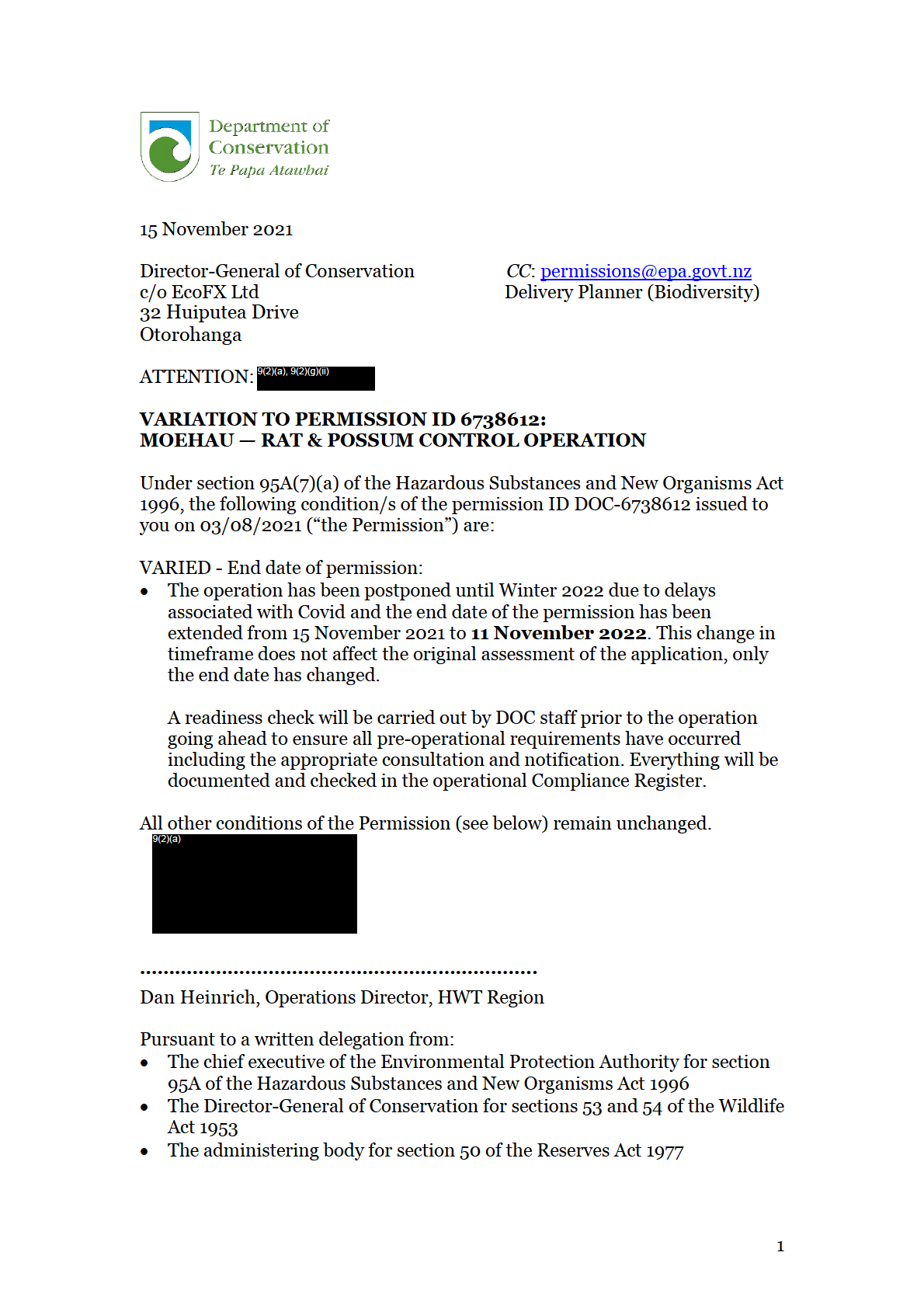
Act
Information
Official
the
under
Released
• The Director-General of Conservation for Section 38 of the Conservation
Act 1987
Enc: The original Permission 6738612 (below)
Ref: DOC-6824632
Act
Information
Official
the
under
Released
2
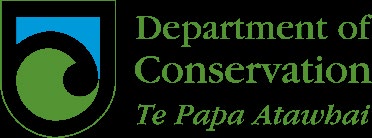 03/08/2021
03/08/2021
9(2)(a), 9(2)(g)(ii)
for the Director-General of
CC:
Conservation
[email address]
EcoFX
Delivery Planner
32 Huiputea Drive
(Biodiversity)
Otorohanga
ATTENTION: 9(2)(a), 9(2)
(g)(ii)
,
Act
PERMISSION ID DOC-6738612: MOEHAU — Rat & POSSUM
CONTROL OPERATION
SUBSTANCE APPROVAL NUMBER: HSR002424
Having considered application DOC-6678269
and assessment report DOC-
6689522, and having considered the adverse effects of the use of
Sodium
fluoroacetate 1080 on DOC managed or administered land, I have decided to
grant this permission subject to conditions. I consider that granting this
permission is in accordance with the purpose of the Hazardous Substances
and New Organisms Act 1996, recognizing the life-supporting capacity of
ecosystems and the wellbeing of people and communities, and taking into
Information
account the principles and other matters in sections 5, 6, 7 and 8 of that Act. I
consider that the conditions imposed in this permission are consistent with
the approval of the substance.
I also consider that the controlling of pests is in accordance with the General
Policy for National Parks (particularly Policy 4.3).and the Conservation
General Policy (see Section 4.2). These General Policies have been given effect
Official
to through various conservation planning documents and are in line with the
purposes of the conservation legislation. I also understand that the controlling
of pests and the protection of indigenous biodiversity generally gives effect to
the
the principles of the Treaty of Waitangi. I, therefore, consider that permission
to control pests on public conservation land can be granted.
Permission is granted, to take immediate effect, under:
• Section 95A of the Hazardous Substances and New Organisms Act
1996
under
• Section 53 & 54 of the Wildlife Act 1953
• Section 50 of the Reserves Act 1977
• Section 38 of the Conservation Act 1987
for the Director-General of Conservation, or any other person acting under
their authority (including contractors) to apply:
• Pesticide Use - #1 Sodium fluoroacetate 1080 1.5g/kg RS5 cereal pellet aerial
Released
• Pesticide Use - #140 Sodium fluoroacetate 1080 1.5g/kg RS5 cereal pellet
aerial
on or after the date of this letter until 30/11/2021
; and
to undertake the actions approved under the above Acts on the lands managed
or administered by the Department of Conservation and to undertake action
3
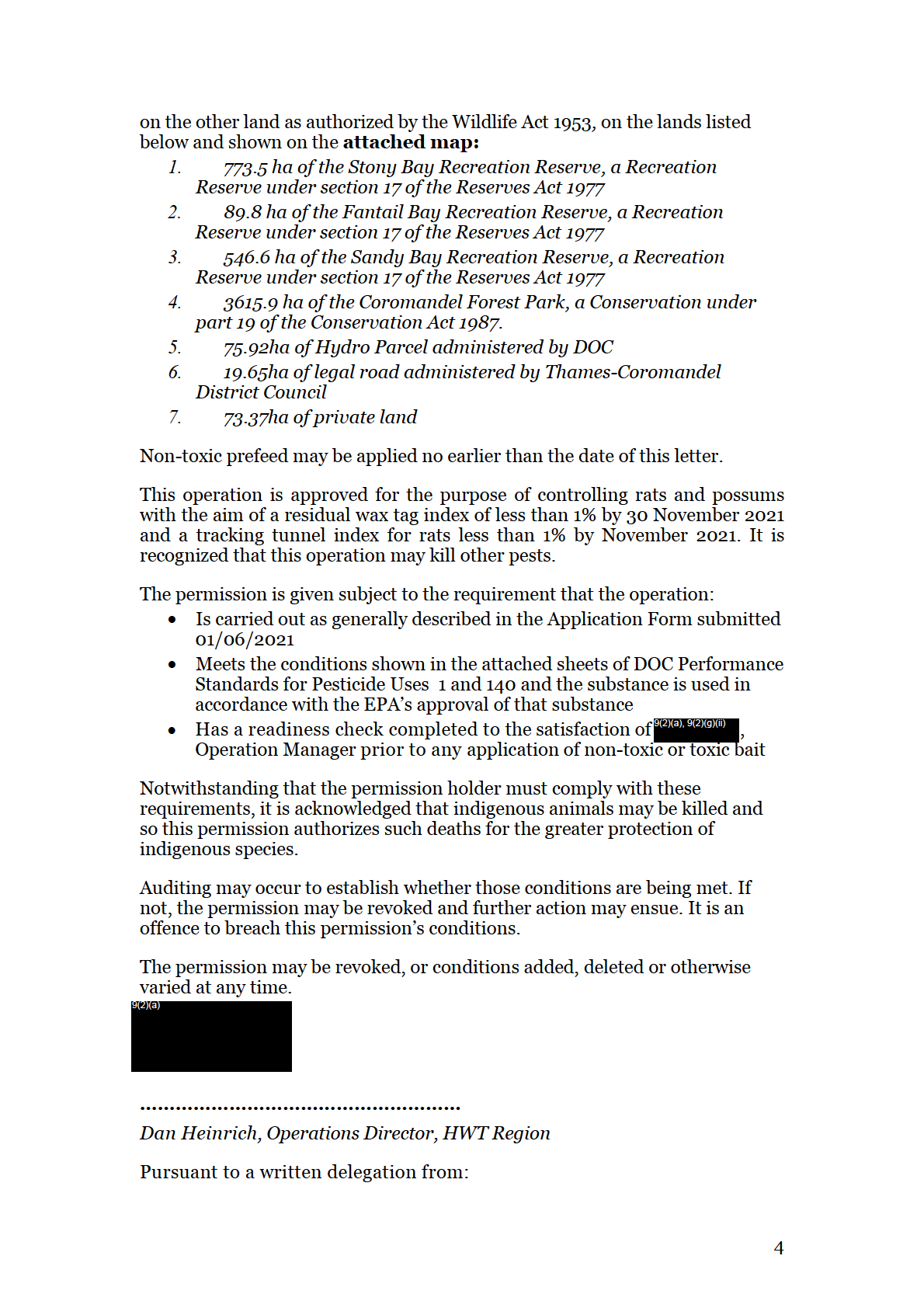
Act
Information
Official
the
under
Released
• The Chief Executive, Environmental Protection Authority for section
95A of the Hazardous Substances and New Organisms Act 1996
• The Director-General of Conservation for sections 53 and 54 of the
Wildlife Act 1953
• The administering body for section 50 of the Reserves Act 1977
• The Director-General of Conservation for section 38 of the
Conservation Act 1987
Act
Enc:
Map
DOC Performance Standards
Application Assessment Report DOC-6689522
Ref: DOC-6738612
Information
Official
the
under
Released
5
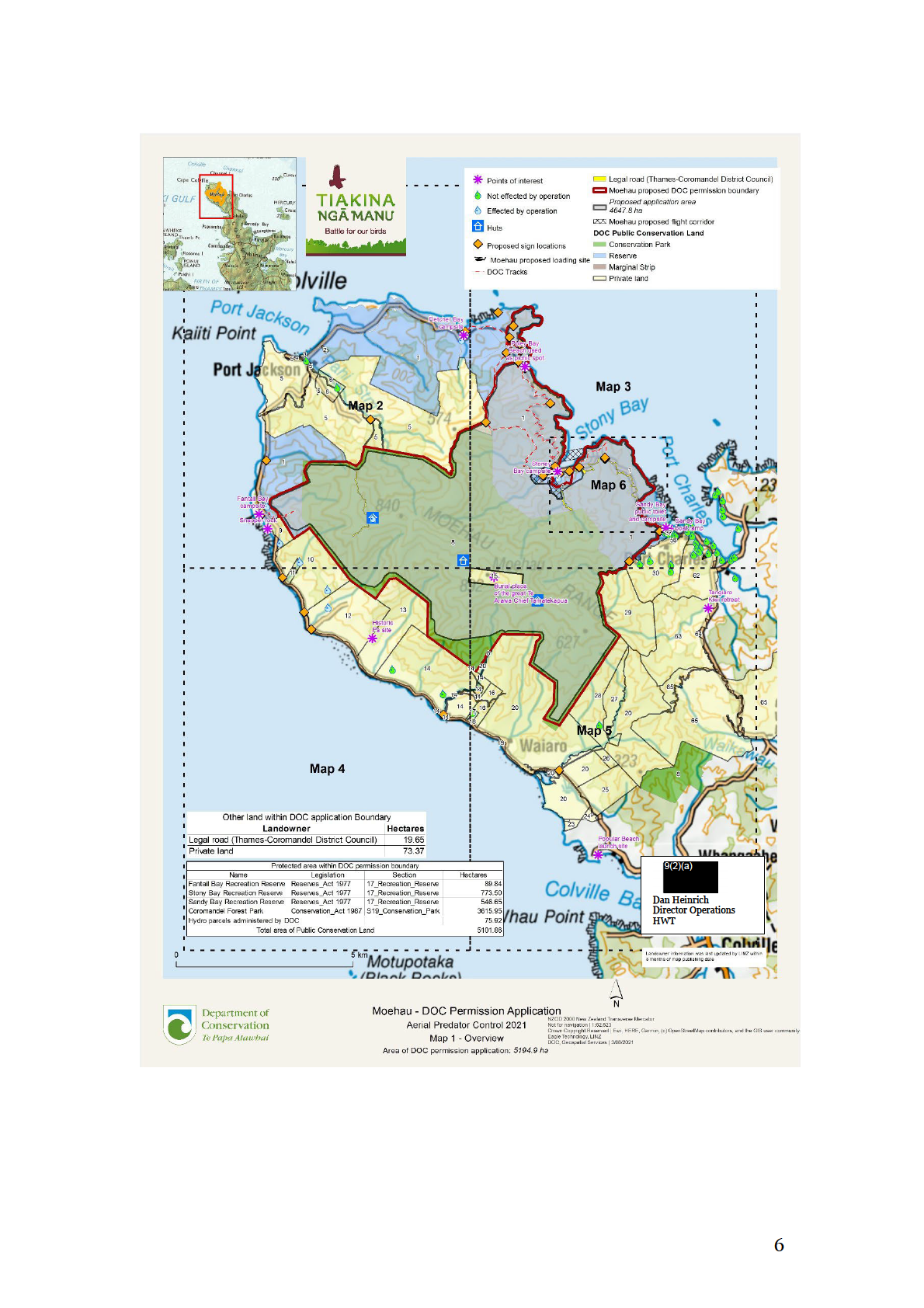
Act
Information
Official
the
under
Released
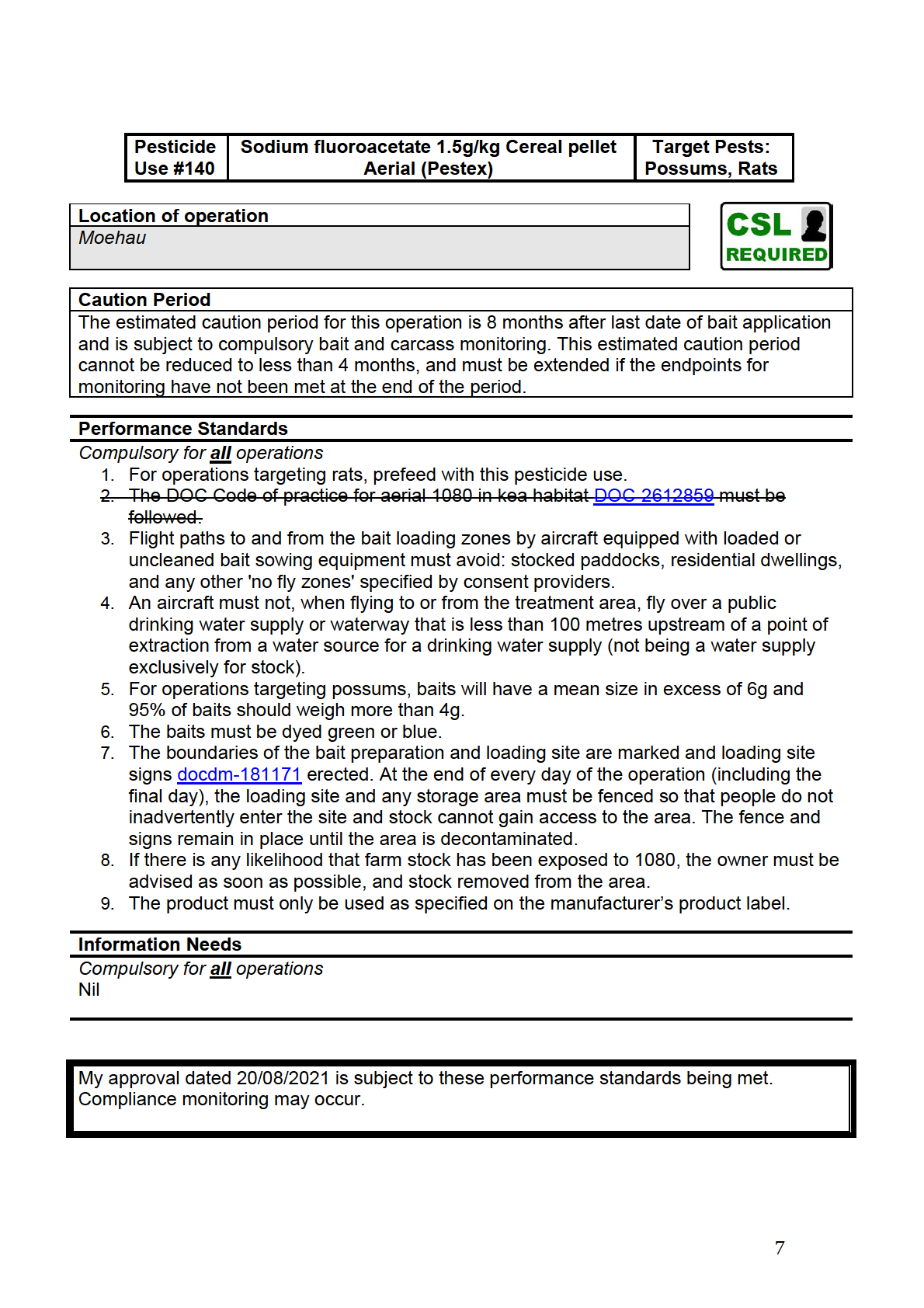
Act
Information
Official
the
under
Released
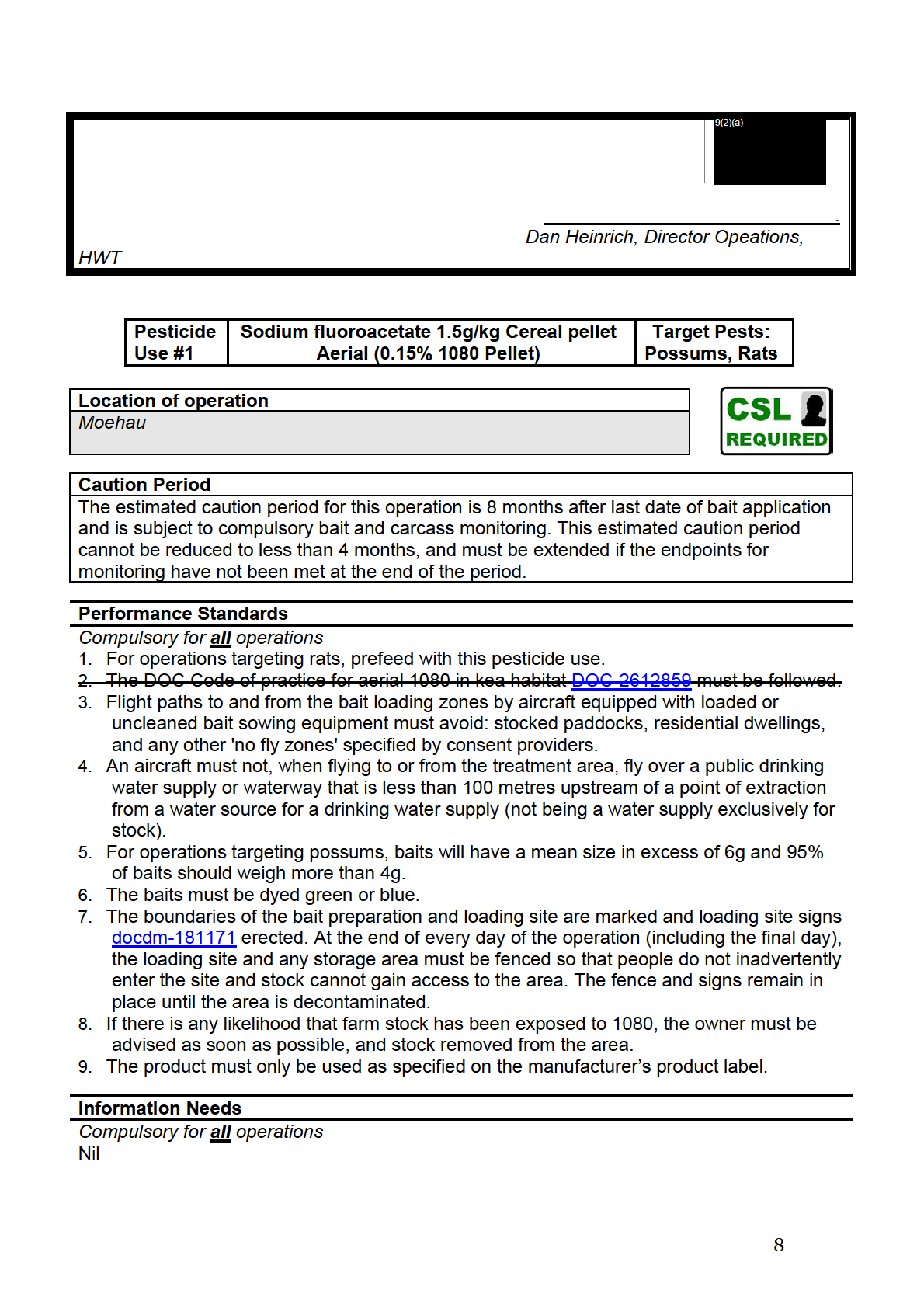
Act
Information
Official
the
under
Released
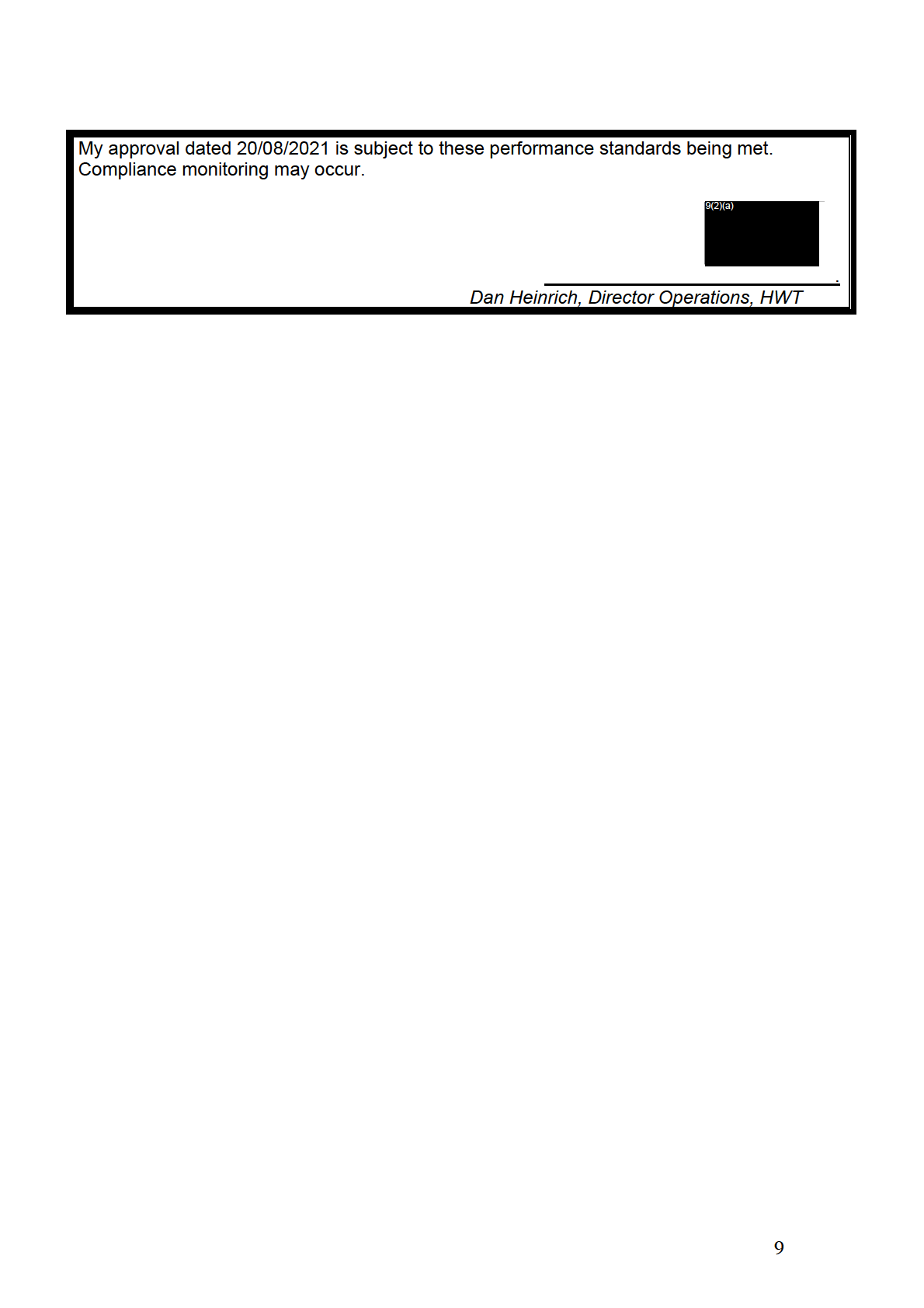
Act
Information
Official
the
under
Released

Pesticides - Decision Support Document (PDSD) (Assessment of
Vertebrate Pesticide Permission)
Application Details
Applicant1
EcoFX Ltd for the authority of the Director General of
Conservation
Act
Date received
1/06/2021
Permission Number
94667 - PCO
Substance approval
HSR002424
Number (s)
Short description of
Application Form for Possum and Rat control in the Moehau
application
area
Information
Public Health Permission
21-184-BET-WAPH-MOEHAU_2021_Aerial
ID (if applicable)
Document Links
Official
Application Link
DOC-6678269
Task Assignment
DOC-6678274
the
Decision Due
12 July 2021 – ext. required due to pending actions and iwi
consultation
under
Resources
Assessor
9(2)(a), 9(2)(g)(ii)
Permissions Advisor
9(2)(a), 9(2)(g)(ii)
District Office/s where
Hamilton Office
application assessed
Released
1 The Applicant is the Director-General of Conservation for a Departmental operation, including when a
contractor is making the application on behalf of the Department. Any such permission should be granted
in the name of the Director-General and cover staff and contractors, and addressed to the Director-General,
care of the contractor. Where the Application is not the Director-General, provide the External Applicant
Name, which will normally be a company and should also include staff and contractors.
1
Vertebrate Pesticide - Decision Support Document DOC-6096407

Act
Information
Official
the
under
Released
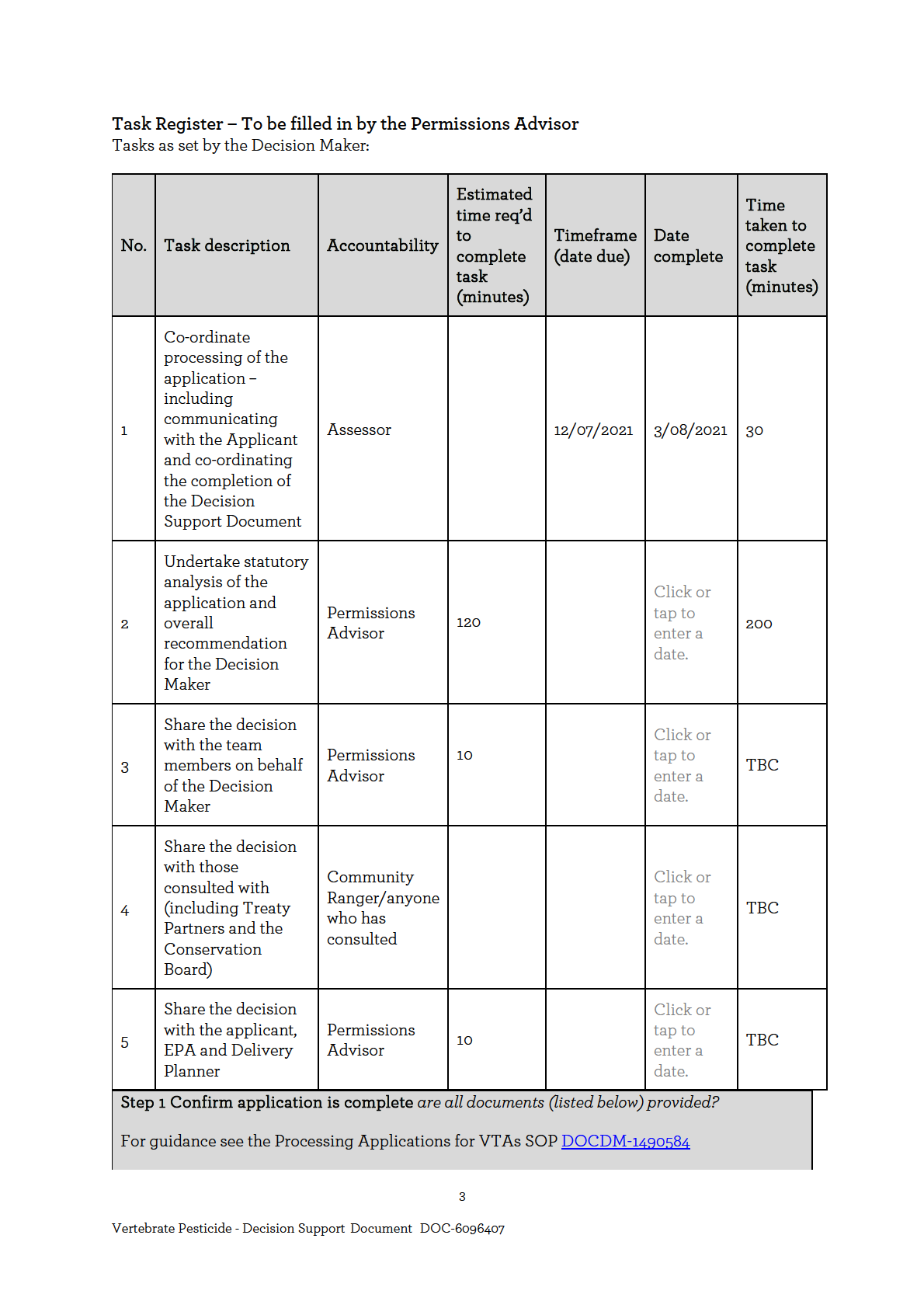
Act
Information
Official
the
under
Released

Act
Information
Official
the
under
Released
DOC Pesticide summary shapefiles (N/A to DOC operations and Possum
N/A
hunters using cyanide paste)
Are the control methods clearly assigned to each treatment block? Do
operational boundaries and warning sign locations match the DOC permissions
map(s)?
Consultation record including conditions of non-DOC landowner consents. Yes
Iwi and hapū, landowners adjacent to operational area, schools,
Act
concessionaires, hunting groups & other interested groups should be identified,
contacted and be consulted with (not just informed).
Was level of consultation adequate? Should DOC be undertaking consultation
itself?
Most consultation was undertaken mostly by EcoFX Ltd. Iwi consultation was
undertaken by the department.
Schools, concessionaires, hunting groups & other interested groups have been
Information
identified and notified.
The communication plan does not provide detail on adjoining landowner
consultation – notification only. Further evidence is required. Request for
updated communication record sent on 25/06/2021 and updated record
received on 28/06/2021.
Official
The updated communication plan includes communication records for
landowners, iwi, etc. Adjoining landowners have still only received notification.
This was queried via email on the 29/06/2021. The reply was received on the
the
29th. to point out that Stony Bay residents are not adjoining and will be
changed from adjoining to interested parties.
Consultation is ongoing.
under
All required owner/occupier consents obtained?
Yes
Are conditions of consent from non-DOC owners evident in the application?
LINZ Consent still outstanding. LINZ have advised they cannot give consent
as the parcels are not listed on the LINZ balance sheet.
9(2)(a), 9(2)(g)(ii)
followed up on the LINZ land with our statutory land team and in
an email received on 8th July 2021 was informed that we can consider this land
Released
as being managed by DOC and don’t require permission from anyone else to
treat this land as part of the operation.
TCDC consent sent 16/06/2021
5
Vertebrate Pesticide - Decision Support Document DOC-6096407
9(2)(a), 9(2)(g)(ii)
signed consent on 15/06/2021.
Was consultation undertaken with appropriate iwi/hapū?
Yes
List of consulted iwi was sent to 9(2)(a), 9(2)(g)(ii)
to check appropriateness on
the 29/06/2021. 9(2)(a), 9(2)
(g)(ii)
confirmed that the appropriate iwi/hapu have been
consulted.
Act
Should DOC be undertaking consultation itself?
Communication plan does not show consultation. Notification has been
provided to iwi, but detail is missing on responses. Updated communication
plan was sent on the 28/06/2021.
Updated communications plan shows Iwi consultation is being undertaken by
the department and is ongoing. Some iwi groups have responded either
showing opposition or support while others are yet to respond. The level of
engagement so far is satisfactory.
Information
Public health permission/ proof of application
Proof of application for public health permission is adequate to process the
Yes
application, as long as the public health permission and associated application
form is sighted prior to approval.
Official
Public Health Permission application provided, the permission will need to be
sighted before approval can be given. the
Public Health Permission received on the 02/08/2021
https://doccm.doc.govt.nz/wcc/faces/wccdoc?dID=8623276&dDocName=DOC-
6739675
Your confirmation email and subsequent correspondence
under
Further information regarding a map depicting A3 warning signs and a
completed consultation record was requested on the 25/06/2021
Requested information was sent on the 28/06/2021
Thank you for your application for permission to control rats and possums at
Moehau.
•
Your application was received on 01/06/2021
Released
•
I will be the assessor for your application and a contact point for
anything related to its processing. My contact details are below.
•
I require further information in order to continue with the processing of
your application. The information you need to supply is:
o
Evidence of iwi consultation
o
Maps that identify the location of A3 warning signs
6
Vertebrate Pesticide - Decision Support Document DOC-6096407
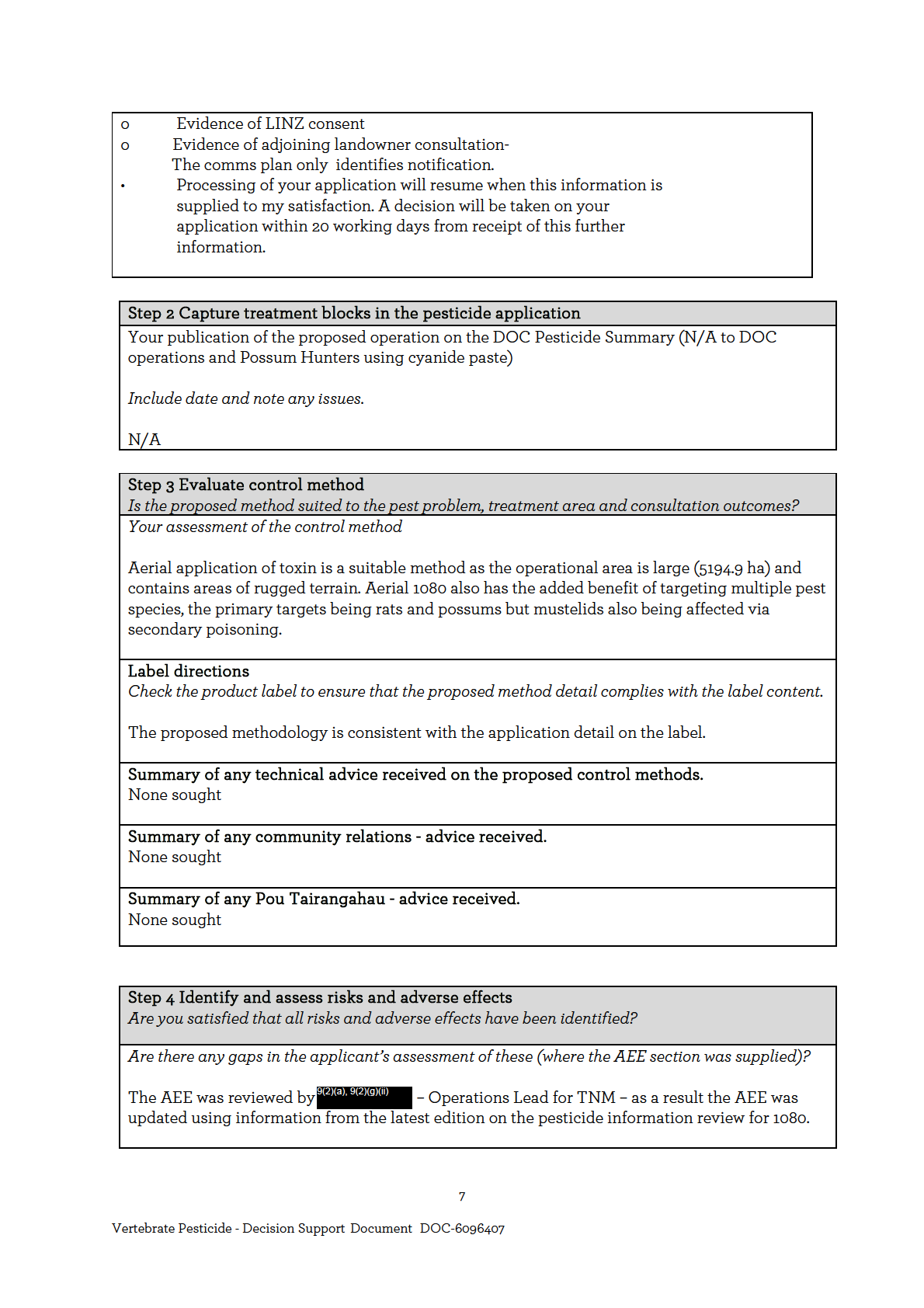
Act
Information
Official
the
under
Released
Note If no AEE is required, put N/A. AEE requirements are set out in the "status list” DOC 22655.
Relevant points from the DOC Pesticide Information Reviews (PIR).
• 1080 in baits may be defluorinated in 1–2 weeks under favourable conditions. However, under
less favourable conditions breakdown may take several weeks and, in extreme cold and
drought, 1080 residues could persist in baits for several months.
• Degradation of 1080 is slow in soil and sediments, taking 1-4 weeks under favourable
conditions. The rate of degradation will be influenced by the presence of soil or litter micro-
organisms, and temperature, soil moisture and rainfall. Sodium monofluoroacetate is highly
water soluble so leaching out of soil will occur.
Act
• While the concentration of 1080 in deionised (sterile) water remains relatively constant and
independent of temperature, 1080 degradation occurs within 1-2 weeks in natural water.
Temperature, and the presence of aquatic plants and microbes all affect 1080 degradation in
aquatic environments. Water samples have been collected from streams following numerous
pest control operations using 1080. 96.6% of these samples contained no residues of 1080.
Where residues were found most of these had less than 1 µg l 1 1080. Where higher 1080
residues have been found in water, the samples were mostly from very small streams and/or
associated with the presence of bait, during aerial operations.
• 1080 has a relatively short half-life in sub-lethally dosed animals and it is metabolised and
eliminated from living animals within days. However, it can persist in carcasses for months.
The rate of degradation of 1080 in carcasses will depend on moisture, temperature and the
Information
presence of micro-organisms.
• A total of 243 NI brown kiwi have been monitored during aerial and handlaid 1080 pellet
operations during 8 operations and none have died from poisoning.
Summary of any technical or district advice received
None sought
Official
Other resources consulted (specify)
Poutu, N.; Fairweather, A.A.C.; Broome, K. G. 2020: Sodium Fluoroacetate Pesticide Information
the
Review. Version 2020/1. Unpublished report docdm-25427, Department of Conservation,
Hamilton, NZ. 134p.
Your assessment of technical risks and adverse effects
under
Based on the information provided in the AEE and the pesticide information review, the
proposed use as stated in the application poses a low risk to native species. Although the risk to
native fauna at a population level is low, it is likely some individual deaths will occur during the
operation.
Your assessment of non-technical risks
There is a risk of poisoning to livestock and farm dogs as part of the operational area is grazed
under concession and there is farmland adjacent to the op area. The adjacent farmland consists
Released
of unfenced boundaries where stock have access to the operational area. Risk is low as there has
been timely communication in place and measures are put in place to eliminate likelihood of
stock gaining access.
The area is also used by pig hunters but is tightly controlled due to the risk posed to kiwi.
8
Vertebrate Pesticide - Decision Support Document DOC-6096407
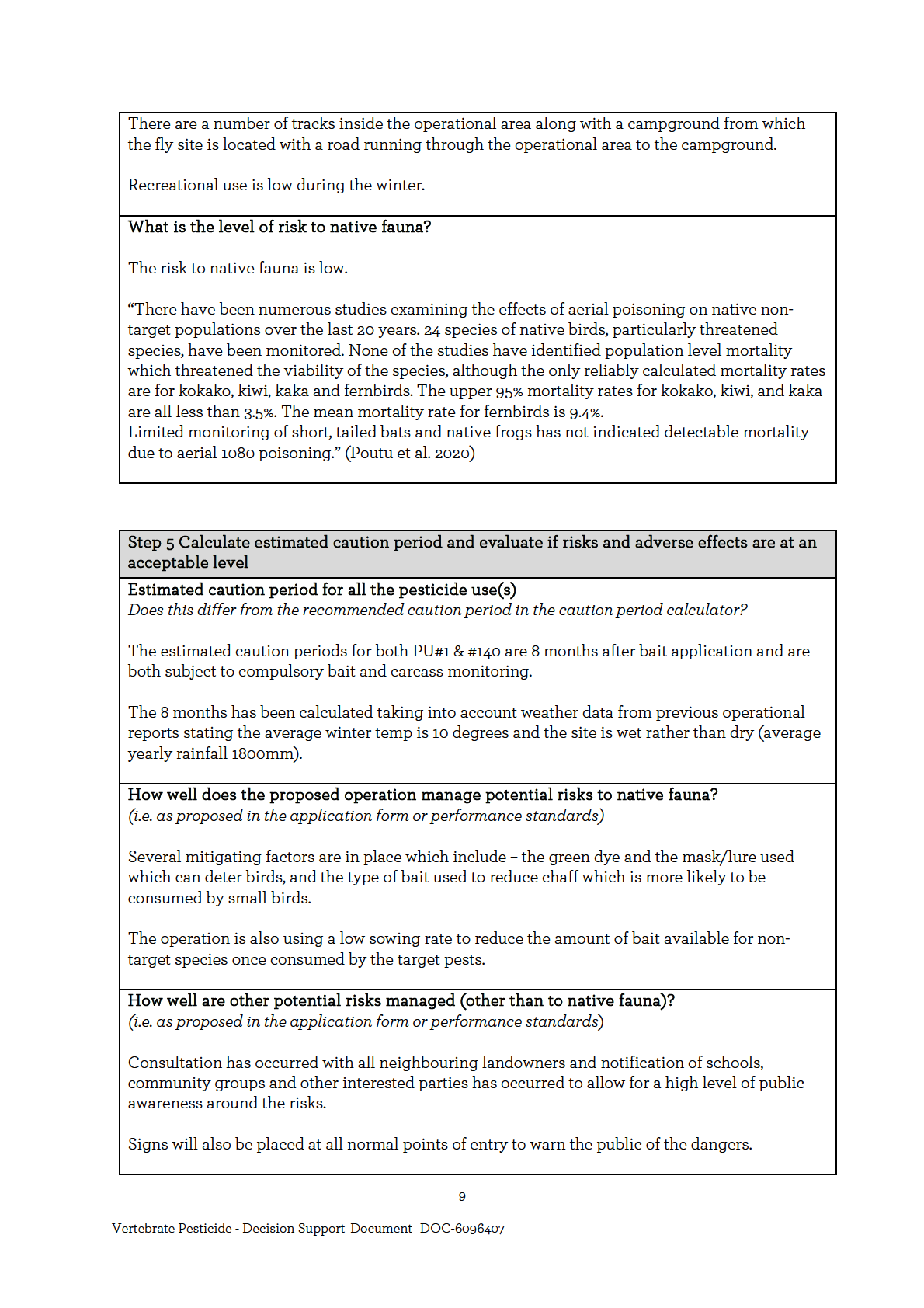
Act
Information
Official
the
under
Released
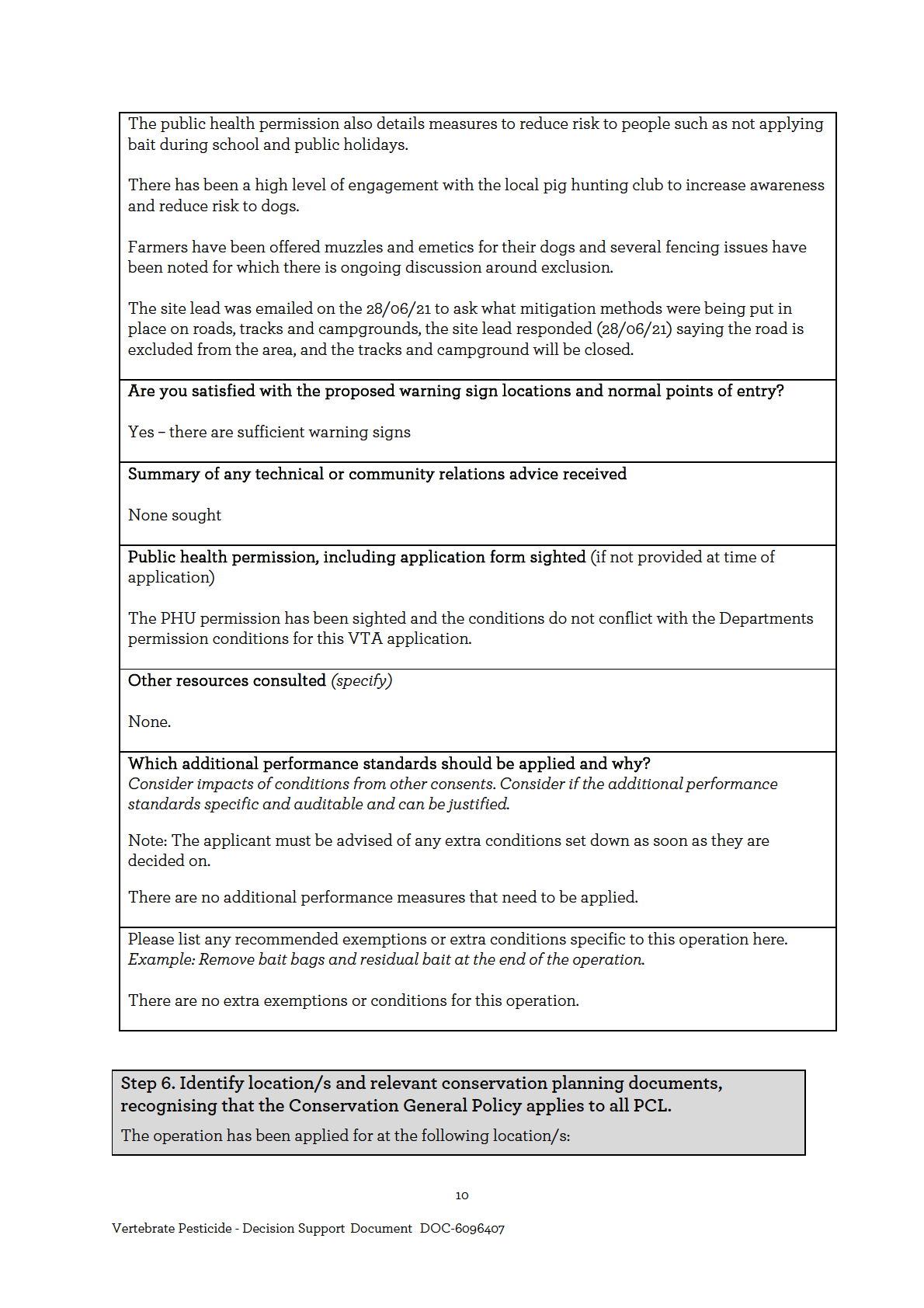
Act
Information
Official
the
under
Released
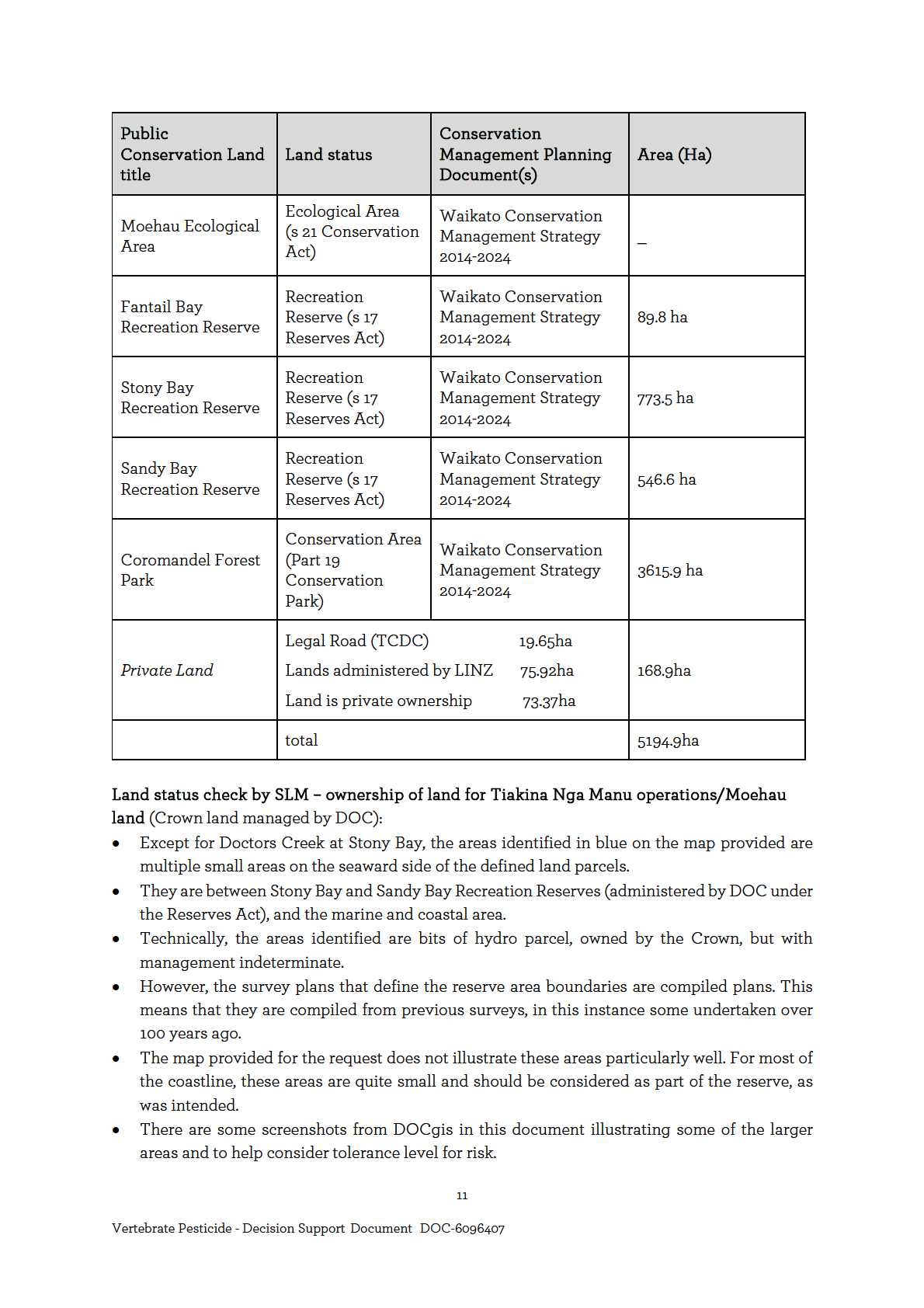
Act
Information
Official
the
under
Released
Consultation by DOC with Māori
Brief analysis/outcome of consultation:
Iwi have been consulted with. Face to face
meeting have been undertaken with follow up
emails with information. Not all iwi are
supportive of the operation but many are and
have expressed their support.
For detail, please refer to Communication
DOC-6507603
Plan:
Act
Analysis of the Principles of the Treaty of Waitangi
Permissions Advisor: Priya Murthi
Section 4 of the Conservation Act 1987 states ‘This Act shall be so interpreted and
administered as to give effect to the principles of the Treaty of Waitangi’. This is applied to all
Acts administered by DOC.
The key principles of the Treaty of Waitangi that apply to DOC’s work are:
Information
1. Partnership – mutual good faith and reasonableness: The Crown and Māori must act
towards each other reasonably and in good faith;
2. Informed decision-making: Both the Crown and Māori need to be well informed of the
other’s interests and views;
3. Active protection: The Crown must actively protect Māori interests retained under the
Treaty as part of the promises made in the Treaty for the right to govern;
4. Redress and reconciliation: The Treaty relationship should include processes to
Official
address differences of view between the Crown and Māori.
Discussion:
the
The Department’s Treaty partners impacted by the proposed activity have been consulted and
are supportive of the proposed activity on their lands. Further to this support this analysis will
ensure that due consideration is given to our treaty partners position and the Conservation
Act 1987 is administered in line with the principles of the Treaty of Waitangi’.
1. Partnership – Mutual good faith and reasonableness has been undertaken by both the
under
crown and our treaty partners through open communication and consultation on the
application in question. Feedback has been sought and received on the proposed activity
in an open and constructive manner
2. Informed Decision Making – Both the crown and iwi have been provided with sufficient
information and time to make a well-informed decision on the application. Such efforts
have included the provision of reasonable time for feedback and ensuring that the
applicant provided iwi with an easily interpreted summary the proposed activity.
Released
3. Active Protection – The Crown has actively protected Maori interests through undertaking
consultation which enables the Department to consider varying perspectives and make a
well-informed decision on the proposed activity.
4. Redress and Reconciliation – Redress and reconciliation will be taken into consideration
with iwi informed of the final decision and the reasoning behind it. Further discussions will
12
Vertebrate Pesticide - Decision Support Document DOC-6096407
be held if issues emerge or questions emerge from our treaty partners before, during or
after the operation
The application and manner in which the crown has consulted affected tangata whenua meets
section 4 of the Conservation Act 1987.
Post Settlement Obligations
Are there any specific post-settlement obligations that relate to the application area? Detail on
individual treaty settlement commitments can be found here:
http://intranet/engagement/tangata-whenua/individual-treaty-settlement-obligations/
Act
Note: Individual iwi and hapū groups must be consulted with as per agreed protocols in
accordance with post settlement obligations.
Discussion:
There are no known post settlement obligations which impact the proposed operation or how
iwi are engaged on the Pesticide activity outside of the standard consultation process.
Statutory Analysis – Permissions Advisor: 9(2)(a), 9(2)(g)(ii)
Information
Hazardous Substances and New Organisms Act 1996 (HSNO Act)
Under the HSNO Act, the Environmental Protection Authority (the Authority) has approved the use
of certain VTAs but has imposed a requirement that:
No person may apply or otherwise use this substance on land administered or managed by the
Official
Department of Conservation unless the person first obtains a permission from the Authority.
All persons exercising powers do so to achieve the purpose of the HSNO Act as set out in section 4:
the
The purpose of this Act is to protect the environment, and the health and safety of people and
communities, by preventing or managing the adverse effects of hazardous substances and new
organisms.
1. When exercising the power of decision, to achieve the purpose of the Act, are the principles
of section 5 recognised and provided for, being:
under
(a)
the safeguarding of the life-supporting capacity of air, water, soil, and ecosystems:
(b)
the maintenance and enhancement of the capacity of people and communities to
provide for their own economic, social, and cultural well-being and for the reasonably
foreseeable needs of future generations.
Yes / No
Discussion:
Released
The proposed activity concerns the use of pesticide on public conservation land for pest
control purposes. Pests targeted include invasive and introduced species which are known to
adversely impact the environment and the
life-supporting capacity of air, water, soil, and
ecosystems. The targeted elimination of pests through the use of pesticide is likely to
enhance the economic, social, and cultural well-being of communities negatively impacted
by the presence of pests.
13
Vertebrate Pesticide - Decision Support Document DOC-6096407
The proposed activity is consistent with Section 5 of the Hazardous Substances and New
Organisms Act 1996.
2. When exercising the power of decision, to achieve the purpose of the Act, have the matters in
section 6 been taken into account, being:
(a) the sustainability of all native and valued introduced flora and fauna:
Discussion:
Act
The use of aerially applied 1080 will promote the sustainable management of valued native
flora and fauna. The purpose of this operation is to reverse the decline of native species. It is
possible deaths could occur in some bird species though population recovery is normally
within one breeding season. The control of pests falls within the scope of sustainable
management.
(b) the intrinsic value of ecosystems:
Discussion:
Pest control measures are essential to ensure that the condition of New Zealand’s native
ecosystems is maintained in order to ensure the ongoing survival of native and valued
Information
introduced species and the protection of indigenous biodiversity. 1080 is the only tool
currently available to achieve rapid and effective pest control in difficult terrain, and is, in
this case, critical to ensuring the sustainability of native and valued introduced flora and
fauna and the intrinsic value of ecosystems.
(c) public health:
Official
Discussion:
Adverse effects can be adequately managed by the controls and by the overall management
regime for 1080. The Ministry of Health is responsible for ensuring that the provisions of the
the
HSNO Act are complied with where it is necessary to protect public health. The EPA has
delegated the function of granting permissions for the use of selected VTAs (to medical
officers of health and health protection officers who are also warranted HSNO enforcement
officers. Human health is therefore also considered through the public health permission.
(d) the relationship of Maori and their culture and traditions with their ancestral lands,
under
water, sites, waahi tapu, valued flora and fauna, and other taonga:
Discussion
The relationship of Maori, culture, traditions, ancestral land, and the value placed on flora
and fauna as taonga has been considered through consultation on the proposed activity.
Acting Pou Tairangahau for the District 9(2)(a), 9(2)(g)(ii)
has provided advice on the relevant
iwi/hapu to be consulted with for both the Moehau and Papakai operations. All iwi/hapu
who claim mana whenua and/or have an interest in the Moehau area have been consulted.
Most are supportive or not opposed, Ngati Rongo-U are the only group strongly opposed.
Released
Ngati Rongo-U are opposed to toxins and request that trapping be used instead. Concerns
also include effects on insects, rongoaa, pigs and community health. The have placed a rahui
on the area with the aim of stopping the operation.
(e) the economic and related benefits and costs of using a particular hazardous substance or
new organism:
14
Vertebrate Pesticide - Decision Support Document DOC-6096407
Discussion:
The use of 1080 has significant benefits for New Zealand, particularly in relation to the
environment and the market economy.
(f) New Zealand’s international obligations.
Discussion:
The use of 1080 enables New Zealand to meet requirements of international obligations
associated with animal health, biodiversity and conservation, including the World Act
Organisation for Animal Health Terrestrial Animal Health Code, the Convention on
Biological Diversity, and the UNESCO Convention Concerning the Protection of the
World Cultural and Natural Heritage 1972.
3. When exercising the power of decision has the precautionary approach in section 7 been
taken into account being the need for caution in managing adverse effects where there is
scientific and technical uncertainty about those effects?
Yes / No
A precautionary approach has been displayed throughout the planning and preparation of
Information
the proposed activity. The pesticides proposed for use are known to be hazardous substances
and as such caution will be taken to manage possible adverse effects. The assessor has
outlined mitigation practices throughout this document which includes recommendations
around caution periods, the placement of toxin warning signs and other forms of risk
mitigation.
The proposed activity is consistent with Section 7 of the Hazardous Substances and New
Official
Organisms Act 1996.
4. When exercising the powers of decision has account been taken of the principles of the
the
Treaty of Waitangi (Te Tiriti o Waitangi)
Yes / No
An assessment of the principles of the treaty of Waitangi and Section 4 of the Conservation
Act 1987 has occurred. Such an assessment can also be applied to Section 8 of the Hazardous
under
Substances and New Organisms Act 1996. As such the principles of the Treaty of Waitangi
has been taken into account through consultation and other means
5. In accordance with section 95A(3) has the following been considered:
(a) the adverse effects involved in the use or uses of the substance to which the application
relates; and
(b) the conditions (if any) that the decision maker thinks should be imposed as part of the
Released
permission.
Note: These conditions are related to conditions which are set out in the performance sheets
attached to the permission as well as the conditions/requirements in the permission letter.
Yes / No
15
Vertebrate Pesticide - Decision Support Document DOC-6096407
Adverse effects involved in the use of substances to which this application relates have been
discussed throughout this document by the assigned assessor. Conditions which will be
imposed by the decision maker as part of any permission for the use of such substances are
outlined in the associated Permissions letter. Conditions noted in the Permissions Letter will
mitigate any possible adverse effects from the proposed activity.
6. Can a permission under section 95A of the HSNO Act be recommended?
Yes / No
Act
Discussion:
Based on the above assessment Permission can be recommended for approval under section
95a of the Hazard Substances and New Organisms Act 1996
Wildlife Act 1953
7. A principal purpose of the Wildlife Act is the protection and control of wildlife within New
Zealand. Any Wildlife Act authorisations can apply to the whole operational area, regardless
of land ownership.
Information
Are individual protected wildlife likely to be killed (are deaths virtually certain) in this
operation, even if that is not desired?
Yes / No
Discussion:
It is well understood that the death of protected wildlife is likely to occur as part of the
Official
proposed operation. The death of protected wildlife through the implementation of this
operation and others is unintended although not unexpected due to the nature of pesticides.
the
Internal Department of Conservation guidance notes that authorities can be granted for the
incidental killing of protected specimen as a result of by-catch. Such an activity can be
approved when conservation benefit outweighs anticipated adverse effects of the proposed
activity.
8. Are conditions imposed that will limit such incidental deaths?
under
Yes / No
Discussion:
The associated Permissions Letter authorising the use of pesticides contains relevant
conditions to mitigate adverse effects and limit incidental deaths. As noted above conditions
will be imposed by the decision maker as part of any permission for the use of pesticide
substances which may impact protected specimen under the Wildlife Act 1953.
Released
9. In these circumstances can it be recommended that an authorisation be granted by the
Director-General under section 53 of the Wildlife Act to kill protected wildlife as a result of
this operation because it will, in the longer term, aid the protection of wildlife?
Yes / No
16
Vertebrate Pesticide - Decision Support Document DOC-6096407
10. Section 54 enables the Director-General to authorise the killing of animals that he is satisfied
are causing damage to other wildlife or land. Are the targeted animals causing damage so
that a section 54 authorisation can be granted?
Note: If the operation is to be on a wildlife sanctuary (s 9 of the Wildlife Act), wildlife refuge
(s 14 of the Wildlife Act), or a wildlife management reserve (s 14A of the Wildlife Act) then
specific consideration will be needed in accordance with the requirements of the Wildlife Act
and the conditions that apply to those areas.2
Yes / No
Act
Discussion:
Pests targeted in the proposed pesticide operation are known to cause damage to
Conservation Land and other specimen protected under the Wildlife Act 1953. The Director-
General is enabled to take appropriate measures and authorise the killing of animals that are
causing damage to wildlife or land.
Wild Animal Control Act 1977
11. Section 17 enables the Minister to authorise the hunting or killing of wild animals (including
deer, chamois, thar, goats and pigs) on land administered by the Department.
Information
12. Does the operation seek to target wild animals on land administered by the Department?
Yes / No
Discussion:
No wild animals will be targeted as part of the proposed operation. The operation instead
Official
targets possums and rats.
13. Would the hunting or killing of wild animals be consist with the Conservation General
the
Policy, any relevant wild animal control plan, and the relevant conservation management
strategy?
Discussion:
Conservation General policy is silent on the proposed activity and as such it is not
inconsistent with Conservation General Policy 2005. The Waikato Conservation
under
Management Strategy 2014-2024 states that priority is to “control and manage animal pests
and wild animals… protect populations of threatened and at-risk species within Waikato”.
14. Can authorisation under section 17 of the Wild Animal Control Act 1977 be recommended to
be granted by the Minister?
Yes / No
Discussion:
Released
2 Domestic animals, rabbits, hares, and most invertebrates are not “animals” for the purposes of the
Wildlife Act, and so section 54 authorisation is not needed where those species are targeted. Deer,
chamois, goats, thar and pigs are not “wildlife” for the purposes of the Wildlife Act, and so section 54
authorisation is not needed where those species are targeted. Those species are “wild animals” subject to
the Wild Animals Control Act 1977.
17
Vertebrate Pesticide - Decision Support Document DOC-6096407
The proposed pesticide operation is consistent with provisions set out in section 197 of the
Wild Animal Control Act 1977 and as such can be recommended for approval.
National Parks Act 1980
15. Does the operation area include a National Park?
Yes / No (if No, then move to next heading)
Conservation Act 1987
Act
16. Authorisation under the Conservation Act is concerned with conservation areas. Although
the authorisation for “hunting” both indigenous animals and pests can be granted under s 38,
the specific tests for each type of conservation area have to be considered.
What types of conservation area are included in the proposed operation area?
Title
Section
Considerations
Conservation Park
19
Natural and historic resources protected and,
subject to that, facilitate public recreation
Information
and enjoyment.
Ecological areas
21
Managed to protect value for which area is
held: the protection, maintenance, and
management of native trees and other plants,
and for the protection of native wildlife, and
for scientific purposes.3
Official
17. If there is wilderness area within the operation area can a recommendation be made to the
the
Minister to grant an authorisation, (noting limits on vehicle and helicopter use)?
Yes / No
Discussion:
Not applicable as no Wilderness Areas are under application
under
18. Is the operation in accordance with the relevant tests which apply to the conservation areas
(other than wilderness) within the operation area?
Yes / No
Discussion:
The proposed pesticide application is consistent with the purpose for which the conservation
areas listed above are held. Long term the natural values associated with listed conservation
Released
areas are protected and enhanced through such operations.
19. If yes, note that section 17A of the Conservation Act requires all conservation areas to be
managed in accordance with the Conservation General Policy and the relevant conservation
3 The Moehau Ecological Area Notice 1977.
18
Vertebrate Pesticide - Decision Support Document DOC-6096407
management strategy. Policy 4.1(a) recognises the importance of indigenous species,
habitats, and ecosystems; and Policy 4.2(b) provides the following policy direction:
i)
preventing pests becoming established, including illegal and inadvertent transfers;
ii)
eradicating newly naturalised pests at places, where practicable;
iii)
eradicating, containing, or reducing the range of pests that are established but not
widespread, where practicable; and
Act
iv)
controlling widespread pests where this is required to protect indigenous species,
habitats, and ecosystems, where eradication or containment of them is not
practicable
20. Is the operation in accordance with Conservation General Policy and any relevant
conservation management strategy?
Yes / No
Discussion:
The proposed pesticide operation is consistent with Conservation general policy and the
Information
relevant Conservation Management Strategy which supports pest eradication though
appropriate measures.
The application is consistent with the Conservation General Policy and the Waikato
Conservation Management Strategy (CMS) (2014-2024) which supports pest eradication
through appropriate measures. Waikato CMS Objectives (Part 1, 5.1.1.1) includes objectives
and priorities to protect and restore and maintain the diversity of New Zealand’s natural
Official
heritage including threatened, at risk and iconic species by controlling and managing pest
species.
the
Section 38
Under section 38 of the Conservation Act the Director-General may, if it is in accordance
with a management plan (if any) and having had regard to the safety of the public, issue
permits for hunting. Hunting for the purposes of this section includes the use of poison.
under
21. Is there a management plan for all or some of the conservation area?
Yes / No
22. If so, would the issue of a hunting permit to kill pests and indigenous animals be in
accordance with it?
Yes / No
Released
23. If there is no management plan, would the hunting be in accordance with the conservation
management strategy and/or conservation general policy? [Note, Section 4.2 of the
conservation general policy identifies the need to manage pest threats.]
Yes / No
19
Vertebrate Pesticide - Decision Support Document DOC-6096407
Discussion:
The relevant Conservation Management Strategy and Management Plan are consistent in
their approach to enable hunting to eradicate pests and control other wildlife threats.
Conservation General Policy is silent on the proposed activity. The issuing of a permit to
undertake pest control operations is appropriate and in accordance with the management
strategy.
24. Has public safety has been provided for?
Yes / No
Act
Discussion:
Appropriate mitigation measures (outlined by the assessor in this document) will be taken to
account for public safety during and after the proposed pesticide operation.
25. Can a hunting permit under section 38 of the Conservation Act be recommended to be
granted by the Director-General?
Yes / No
Discussion:
Information
The proposed activity is consistent with relevant criteria to recommend the approval of a
hunting permit under section 28 of the Conservation Act 1987
Reserves Act
25. Is any of the operation area a scenic, historic, nature or scientific reserve?
Official
Yes / No (if No, then move to next heading)
Discussion:
the
Not applicable as the locations are recreation reserves under s 17
26. If yes, will the killing of fauna (both pests and indigenous species) be in accordance with the
management of that reserve type (Refer s 18 historic; s 19 scenic; s 20 nature; and s 21
scientific)?
under
Yes / No N/A
27.Will the reserve be managed in accordance with any conservation management plan,
conservation management strategy and / or Conservation General policy?
Yes / No N/A
28. Can a recommendation be made to the Minister to authorise the killing of fauna on such
reserves? [Note such a recommendation cannot be made if an authorisation under the Wildlife
Released
Act is not recommended.]
Yes / No N/A
29. Is the land within the operational area recreational, government purpose or local purpose
reserve?
20
Vertebrate Pesticide - Decision Support Document DOC-6096407
Yes / No
Discussion:
Recreation reserves are for the purpose of providing areas for the recreation and sporting
activities and the physical welfare and enjoyment of the public, and for the protection of the
natural environment and beauty of the countryside, with emphasis on the retention of open
spaces and on outdoor recreational activities, including recreational tracks in the countryside
s 17(1) of the Reserves Act). Having regard to this general purpose, the reserve is required to be
administered so that public has freedom of entry and access to the reserve, subject to any lawful
Act
restrictions (s 17(2)(a)). Where scenic, historic, archaeological, biological, geological, or other
scientific features or indigenous flora or fauna or wildlife are present on the reserve, those
features or flora or fauna or wildlife are to be managed and protected to the extent compatible
with the primary purpose of the reserve (s 17(2)(b)).
The primary purpose of the reserve, providing for recreation, sporting activities and the
physical welfare and enjoyment of the public, will be affected by the operation. There will be a
short-term potential impact on public recreation and enjoyment given the restrictions that are
imposed as a result of the use of hazardous substances. This is, however, for a temporary period
and the protection of natural resources has primacy over public recreation and enjoyment.
Information
To the extent that this operation is about the control of possums and rats, it is in accordance
with the administration of recreation reserves, as the control of possums and rats will protect
the natural environment. It is also in accordance with the general purpose of the Reserves Act
as set out in section 3 which includes “ensuring, as far as possible, the survival of all indigenous
species of flora and fauna, both rare and commonplace, in their natural communities and
habitats”. There is, however, the potential that indigenous fauna may be killed during this
operation. You, as a commissioner for this reserve, need to determine if this can be authorised.
Official
30, If yes, who is the administering body?
the
There is no administering body.
31. If there is no administering body, authorisation for an operation in a recreation, government
purpose, or local purpose reserve will need to be granted by a “Commissioner” appointed by the
Director-General, who has all the powers of an administering body (Reserves Act 1977, s 62(1)).4
under
You are an appointed Commissioner. On the basis of the general purpose of the Reserves Act
and the administration of recreation reserves, you can approve the killing of fauna on the
reserves, under s 50 of the Reserves Act.
Will the killing of fauna (both pests and indigenous) be in accordance with the management of
that reserve type? (Refer s 17 recreation; s 22 government purpose; and s 23 local purpose).
Yes / No
Released
32. Will the reserve be managed in accordance with any conservation management plan,
conservation management strategy and / or Conservation General policy?
Yes / No
4 See “List of Commissioners under the Reserves Act 1977”: DOC-2750343.
21
Vertebrate Pesticide - Decision Support Document DOC-6096407
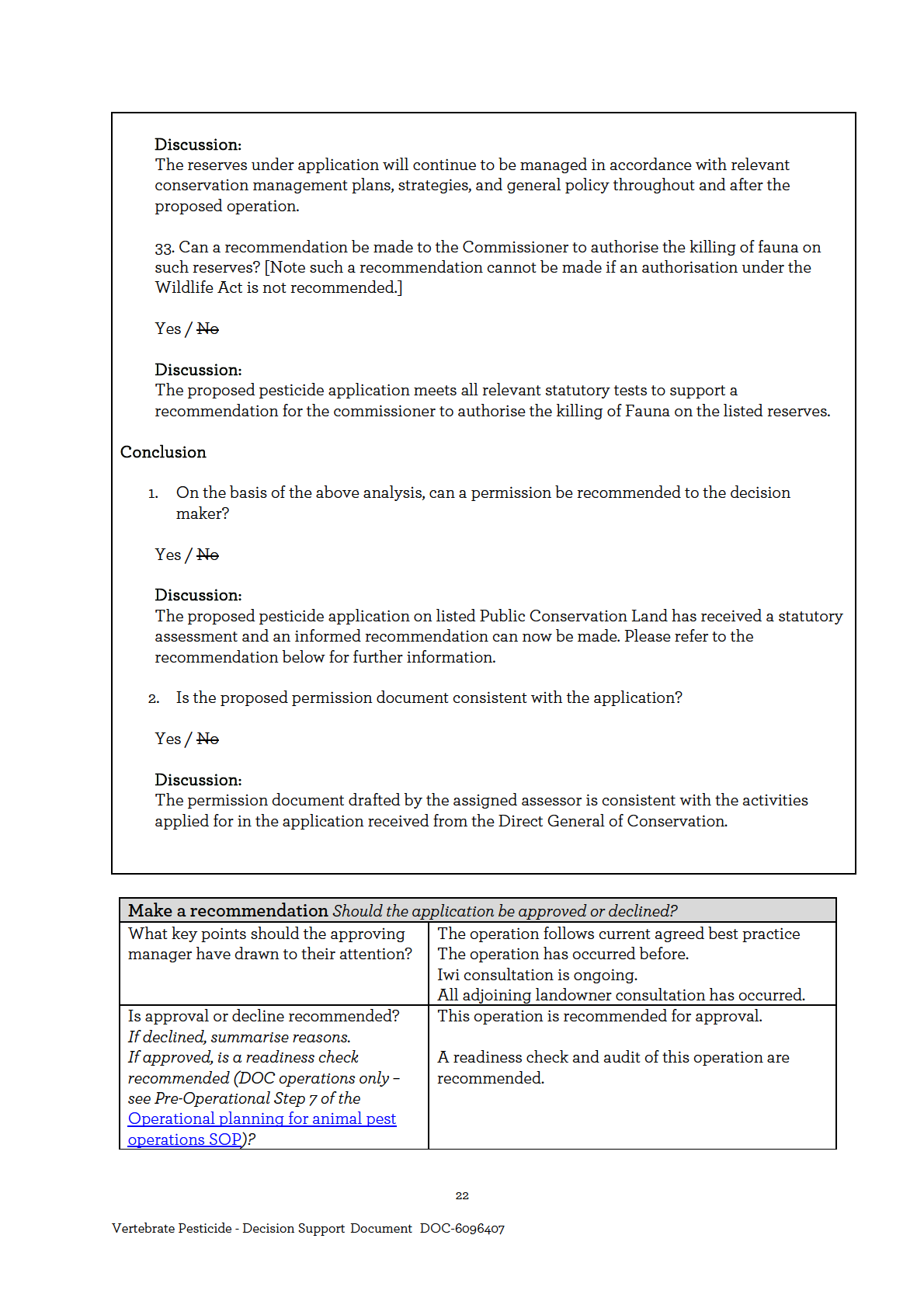
Act
Information
Official
the
under
Released

Act
Information
Official
the
under
Released
4. Agree that the proposed permission and conditions consider the adverse effects of the
use of Sodium fluoroacetate 1080 1.5g/kg RS5 cereal pellet aerial on DOC managed or
administered land and that granting the permission is in accordance with the purpose
of the HSNO Act, recognising the life-supporting capacity of ecosystems and the well-
being of people and communities and taking into account the principles of that Act;
Agree / Disagree
5. Agree, under sub-delegation from the Chief Executive of the Environmental Protection
Authority, to grant permission under s 95A of the Hazardous Substances and New
Act
Organisms Act for the use of Sodium fluoroacetate 1080 1.5g/kg RS5 cereal pellet
aerial on the land managed or administered by DOC in the operation area;
Agree / Disagree
6. Agree you are satisfied that, in the area of the operation, pests are causing damage to
wildlife and land so killing of these pests in general accordance with the application
will meet the purpose of the Wildlife Act;
Agree / Disagree
Information
7. Agree, under delegation from the Director-General of Conservation, to grant an
authorisation under section 54 of the Wildlife Act for the killing of possums and rats
in the operation area in accordance with the methods identified in the application;
Agree / Disagree
8. Agree that, for the purpose of providing greater protection for protected indigenous
Official
species, individual protected wildlife may be killed as a result of this operation even
though the conditions on the permission are complied with, and that this is in
accordance with the purpose of the Wildlife Act;
the
Agree / Disagree
9. Agree, under delegation from the Director-General of Conservation, to grant an
authorisation under section 53 of the Wildlife Act for the killing of protected
indigenous wildlife for the purpose of greater protection of indigenous wildlife in the
under
operation area;
Agree / Disagree
10. Agree, in relation to the area of operation that the Coromandel Forest Park hunting of
animals by the use of poison is in accordance with the purpose of the Conservation
Act, any conservation management plan that applies, and but the operation is in
accordance with the relevant conservation management strategy and conservation
general policy), and that public safety has been provided for;
Released
Agree / Disagree
11. Agree, in relation to the area of operation that is conservation area and under
delegated authority from the Director-General, to grant a permit under section 38 of
the Conservation Act for hunting animals by the use of poison;
24
Vertebrate Pesticide - Decision Support Document DOC-6096407
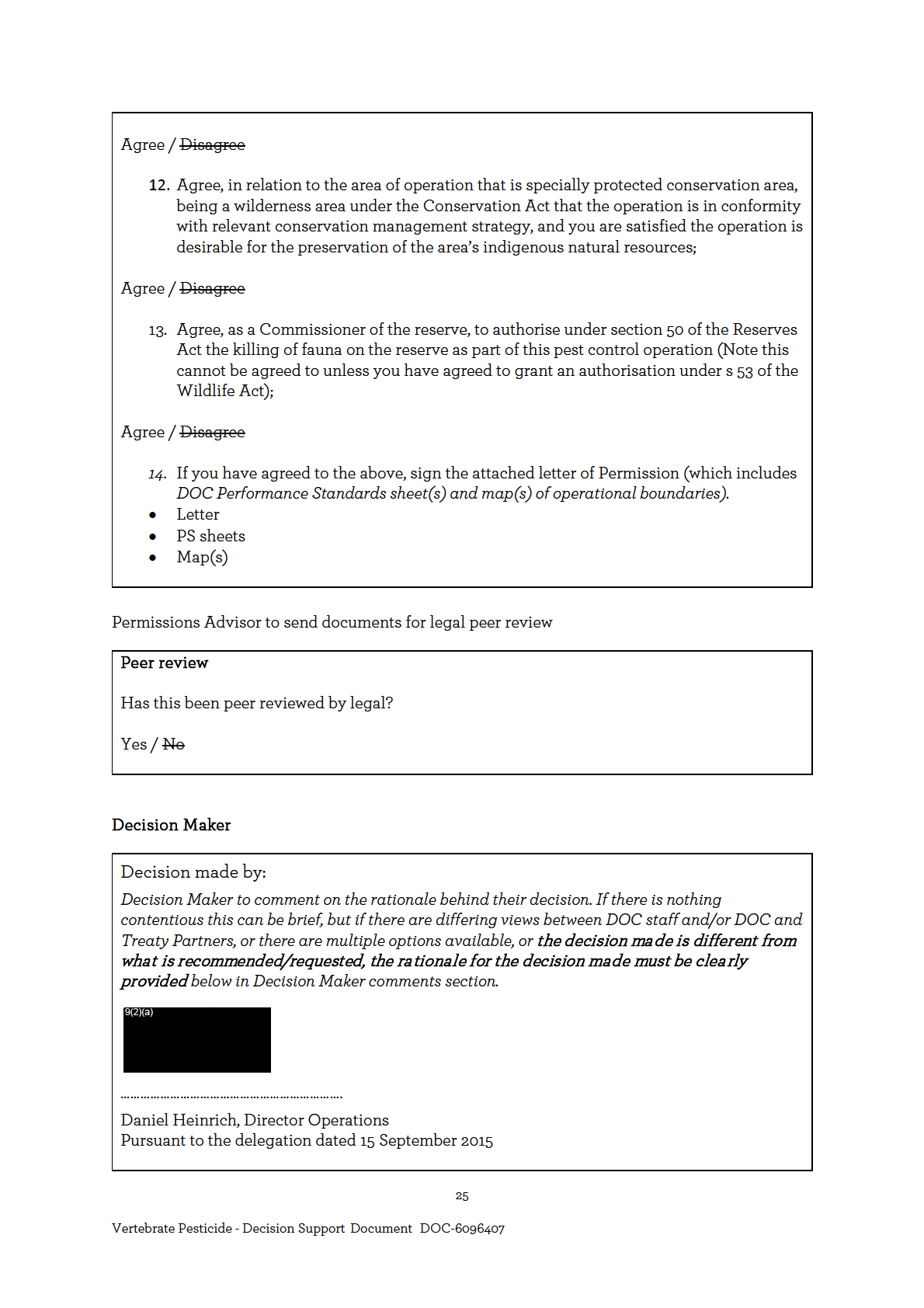
Act
Information
Official
the
under
Released
20/08/2021
_________________
Date
Decision Maker comments – Rationale for Decision
Act
ENDS
Information
Official
the
under
Released
26
Vertebrate Pesticide - Decision Support Document DOC-6096407
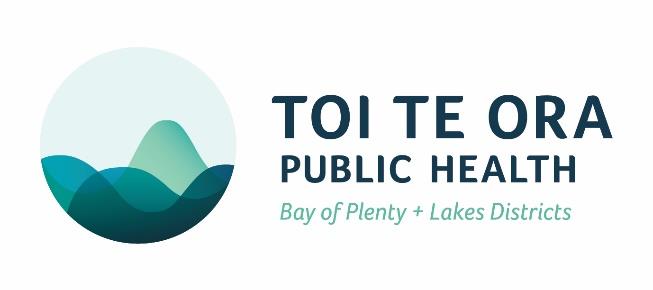
 PERMISSION FOR USE OF
VERTEBRATE TOXIC AGENT(S) AND
OTHER HAZARDOUS SUBSTANCE(S)
PERMISSION FOR USE OF
VERTEBRATE TOXIC AGENT(S) AND
OTHER HAZARDOUS SUBSTANCE(S)
Approved Hazardous Substance Permission Form Version 5: 14 June 2018
Pursuant to section 95A of the
Act
Hazardous Substances and New Organisms Act 1996
To
9(2)(a), 9(2)(g)
(ii)
Of
EcoFx Limited
32 Huiputea Drive,
PO Box 248,
Otorohanga 3900
Application Identification Code
21-028-BNL-TAUPH
Operation Name
Moehau Possum and Rat Control Operation 2021
Information
Application Location
Moehau Treatment Area (Nothern tip of the Coromandel)
Approximately 5149.9 hectares of operational area
Territorial Local Authority(s)
Thames-Coromandel District Council
Purpose of Operation
Possum & Rat Control
Official
I Braden Leonard,
being a person acting under powers delegated by the Environmental Protection Authority (the
Authority), GRANT PERMISSION for the USE of the verteberate toxic agent(s) and/or other hazardous
substance(s) listed in SCHEDULE 1, in the area(s) indicated on the maps in SCHEDULE 3, subject to the
CONDITIONS set out in SCHEDULE 1 and SCHEDULE 2 attached hereto for those hazardous substance(s);
the
This Permission replaces the Permission issued on (date): N/A
Application Identification Code of replaced/revoked Permission: N/A
under
Signed:
Name: Braden Leonard
Title: HSNO Enforcement Officer/Health Protection Officer
Date Issued: 5th November 2021
Contact Person: Braden Leonard
This permission expires on 11th November 2022
Released
Appeals: Section 125 (1A) of the Hazardous Substances and New Organisms (HSNO) Act: A person may appeal
to the District Court against a decision of the Authority, under section 95A about the terms and conditions of a
permission held by the person.
Notice of Appeal: Section 127 of the HSNO Act: Before or immediately after the filing and service of a notice of
appeal, the appellant shall serve a copy of the notice on the Authority, and every other party to the proceedings,
and any other person who made a submission to the Authority.
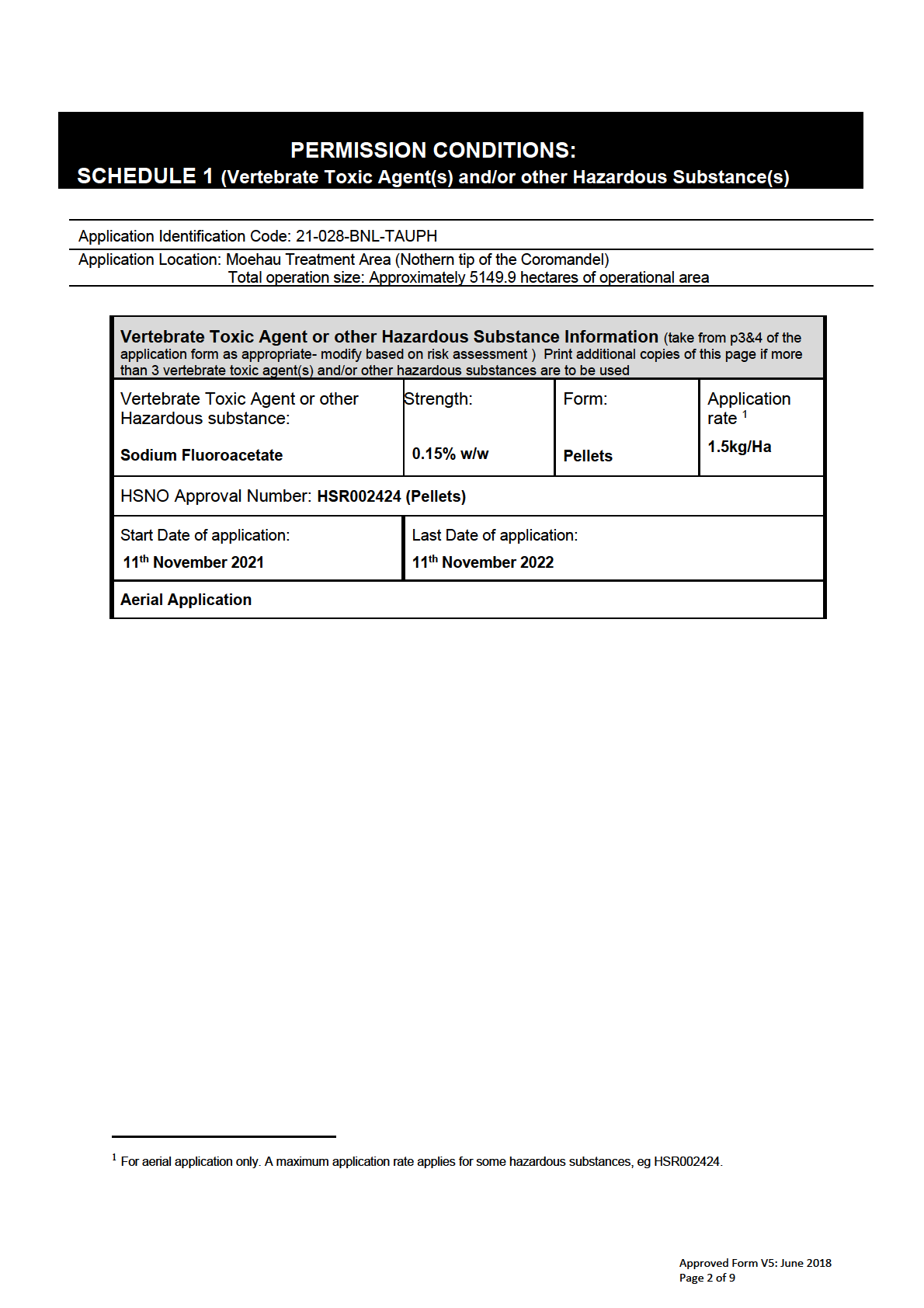
Act
Information
Official
the
under
Released

Act
Information
Official
the
under
Released
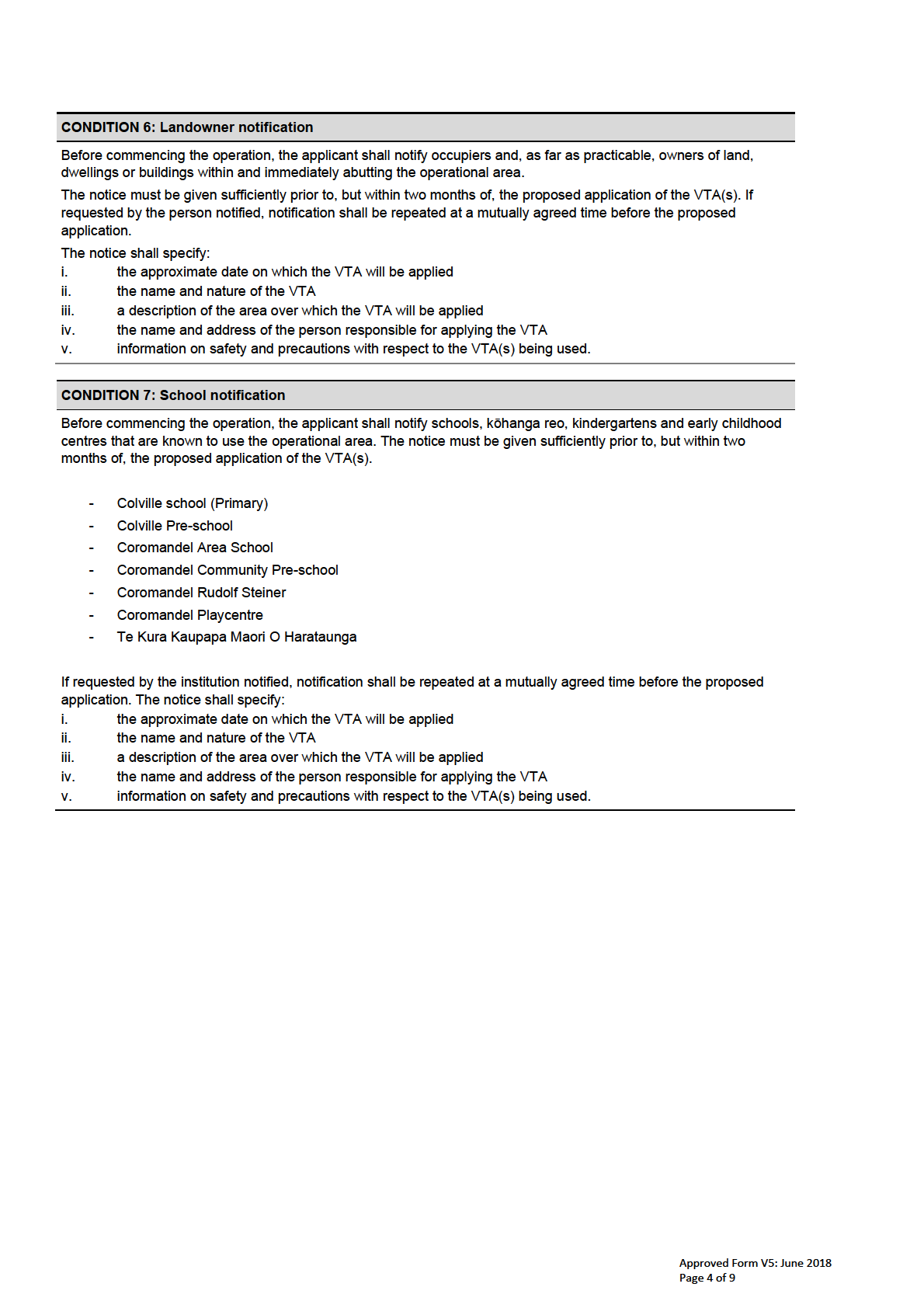
Act
Information
Official
the
under
Released
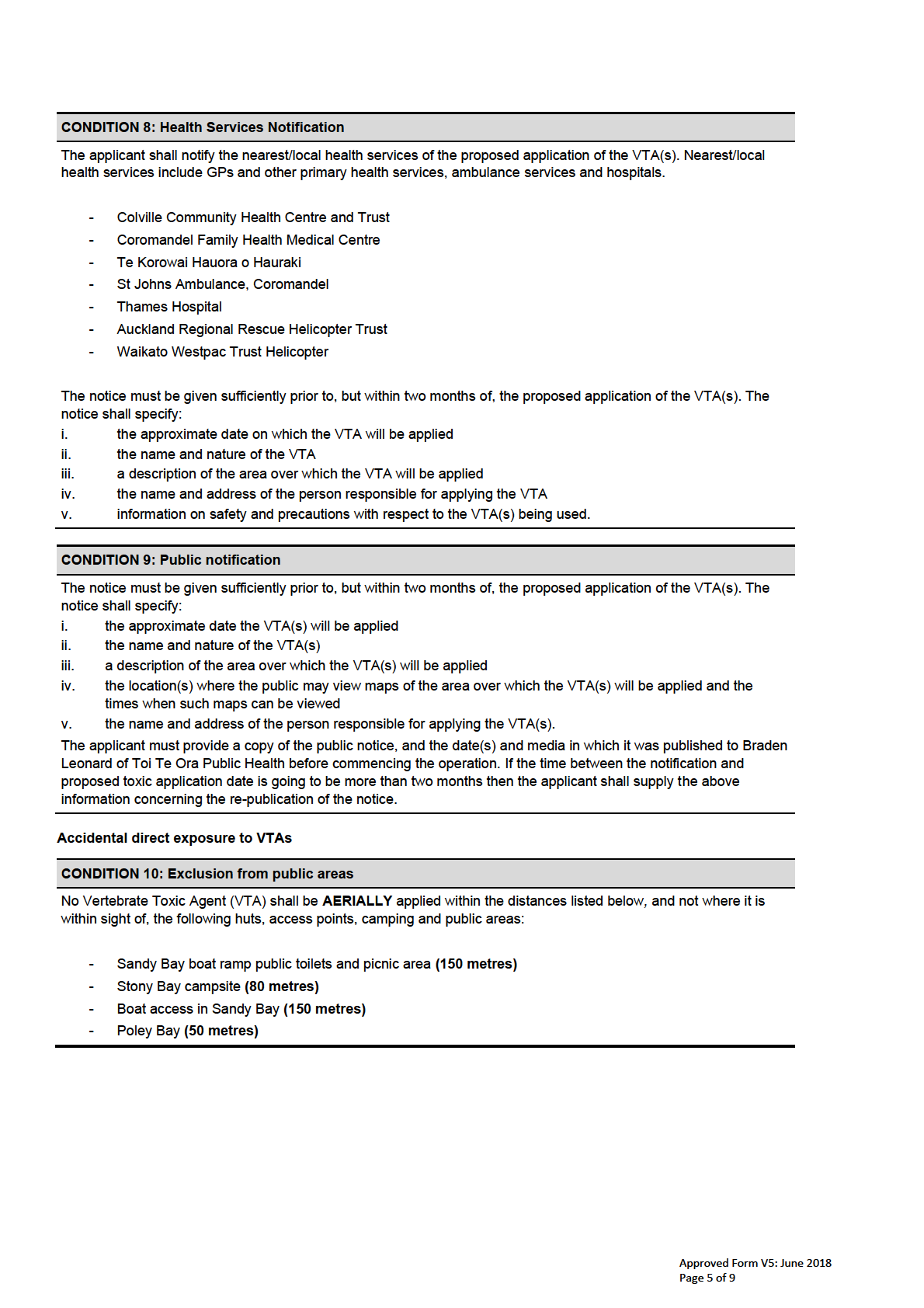
Act
Information
Official
the
under
Released
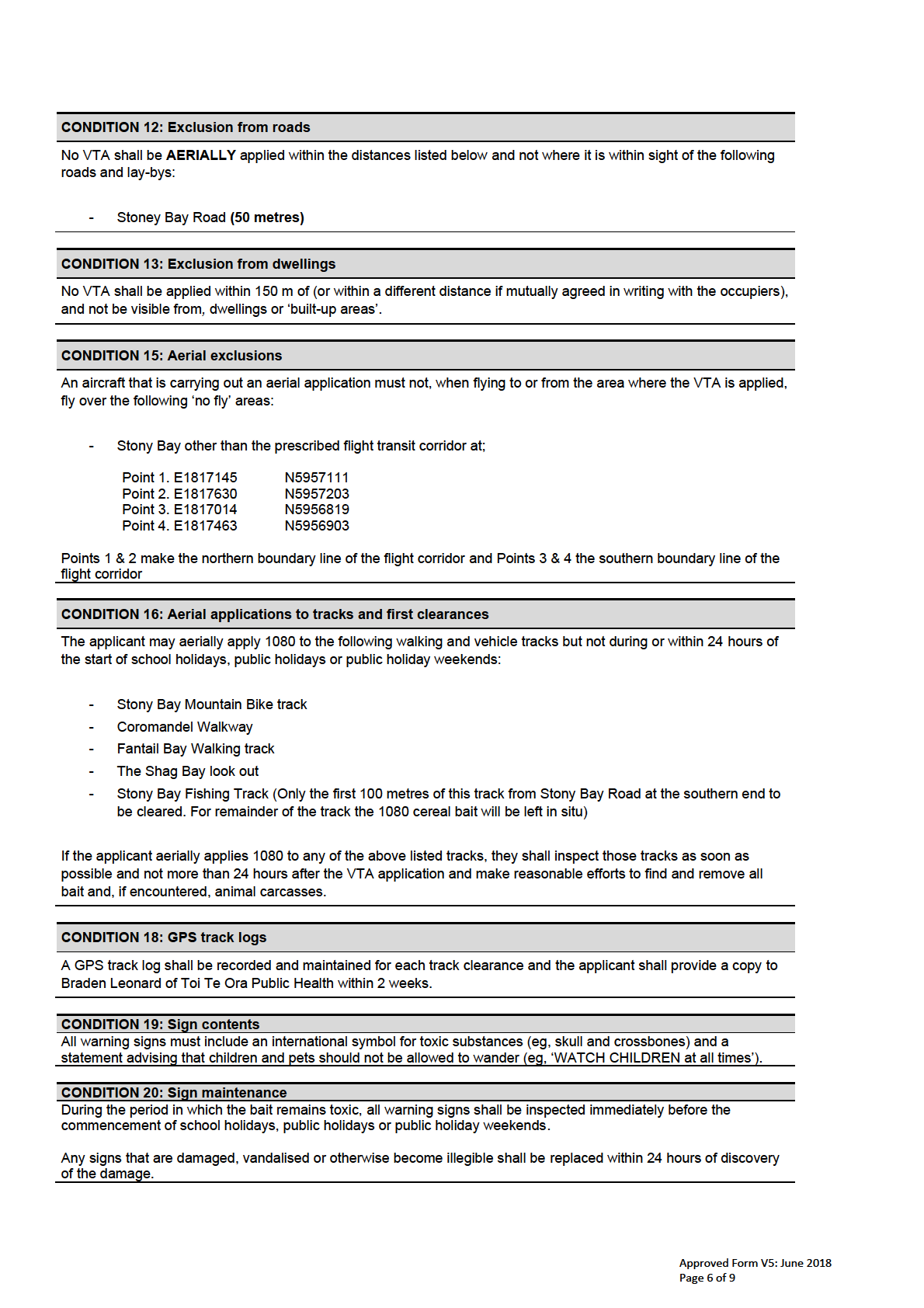
Act
Information
Official
the
under
Released

Act
Information
Official
the
under
Released

Act
Information
Official
the
under
Released
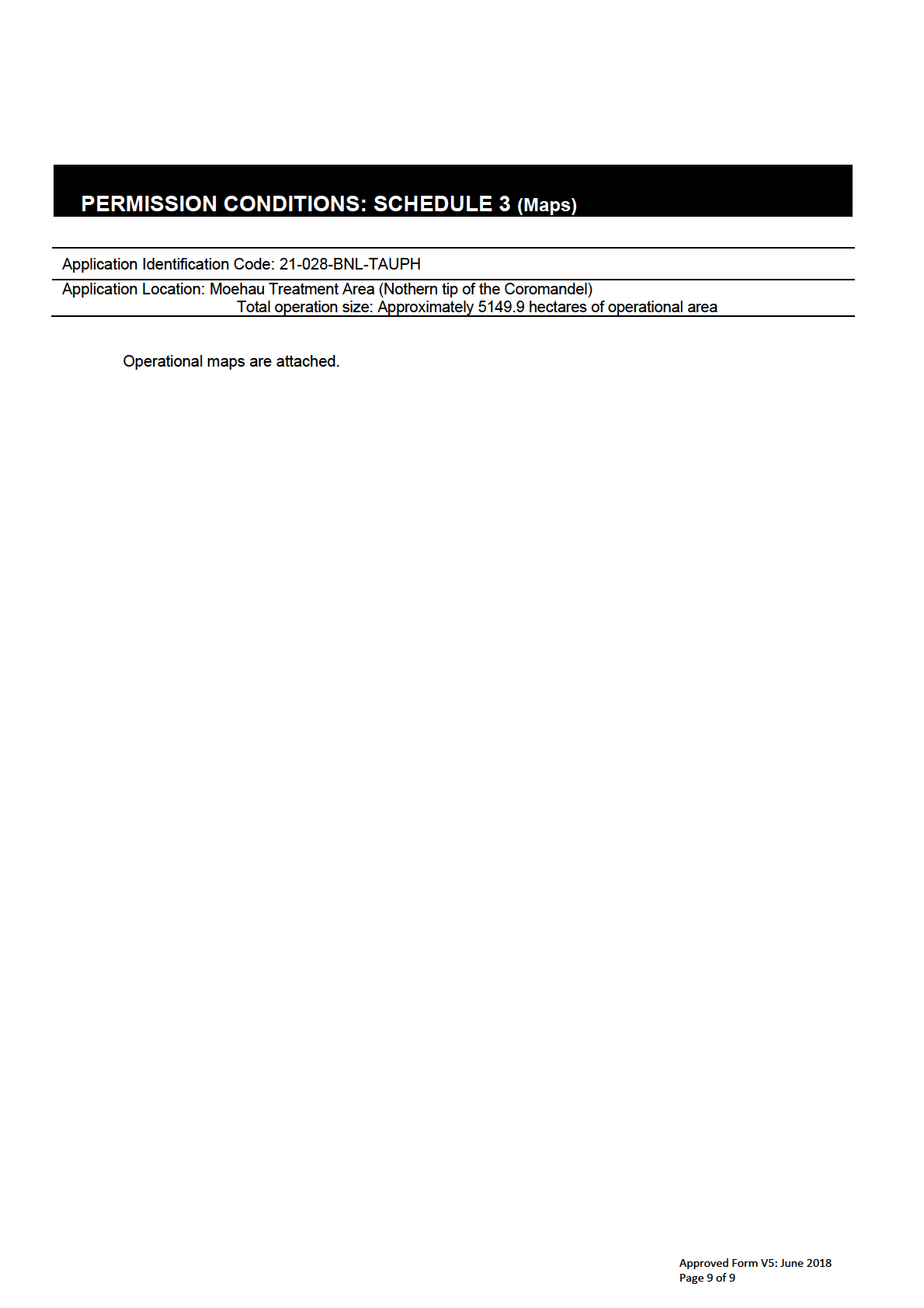
Act
Information
Official
the
under
Released



























